An Australian Greens plan released ahead of the COP21 talks is rich on promise, but the wrong kind. Geoff Russell explains.
The past five years have seen a number of reports about how Australia might move off our elevated position on the podium in the global per-person climate vandalism stakes. The group hugs and beaming grins infecting all manner of Australians at COP21 in Paris promise further breeding of this species.
Typically, these plans call for a move to producing 100 percent of our electricity using wind, solar and burning biomass (forest or other plant crops).
Readers may remember the Beyond Zero Emission plan in 2010 (discussed here), and the Australian Electricity Market Operator modelling work of 2013 which was commissioned by the Federal Government; discussed here and here and here.
In the run-up to COP21, the Greens joined in with a plan called Renew Australia: Powering the new economy.
With the Greens being the only (almost) major political party to take climate change seriously, I’d love to give a ringing endorsement to this plan. But that’s not the way it works.
Peter Doherty’s recent book The Knowledge Wars relates the way science works; if your theory sucks, it doesn’t matter how well meaning or personable you are, or how big the institution is that you head, your arguments will be garotted.
It’s a very successful, if confronting, way of operating. Group hugs are for diplomats and politicians.
So despite my recognition that the Greens have the best of intentions, good intentions aren’t enough.
We start by asking if the plan is a partial plan, or a full one? My last article on New Matilda was about methane and how it’s real climate impact has been obscured by the factors used in UNFCCC greenhouse gas emissions accounting.
Here’s a brief explanation.
Suppose you skull a bottle of whiskey. Assuming you survive, you’ll feel pretty bloody sick. Could you estimate the impact of that event by pretending that you sipped it over the course of a month?
That would be silly, but that’s how methane figures appear in UNFCCC inventories.
Instead of looking at the impact of methane during the couple of decades it takes to break down, which is 105 times that of CO2, that impact is averaged over 100 years which makes it appear merely 25 times more potent than CO2.
The impact of this dodgy accounting factor on perception is huge. Physically, anthropogenic methane, on its own, contributes about half of our net warming influence on the climate. So methane is a really big deal, particularly in Australia with 29 million cattle and 72 million sheep, but it’s totally ignored by Renew Australia.
We could perhaps speculate that methane is ignored because Green’s leader Richard Di Natale has a sideline in cattle. Di Natale’s cattle featured recently on ABC’s Kitchen Cabinet along with his off-grid house and his ex-pig salami.

It’s disingenuous to make money from cattle while preaching concern for the climate, and a doctor making salami is almost as bad as a doctor growing tobacco.
Keeping cattle shows that Di Natale’s understanding of climate science is superficial at best; he doesn’t grok the problem.
And living off grid? Maybe Di Natale has no choice, but living off grid when you have a choice is like living near a railway station and boasting of the suite of vehicles you have to avoid ever using that bloody train.
Having a room dedicated to your tanks of battery acid and enough electronics to open your own Dick Smith shop isn’t smart. It demonstrates an inability to think about proposed solutions at scale.
We need a clean grid and the way to build it isn’t by replacing it with tonnes of battery acid and more people on ladders and roofs.
As Di Natale proudly showed his tubs of battery acid, he enthused: “This is the future!”. Shortly after came the added admission of the generator … just a couple of months of the year.
In the software business we have a rule-of-thumb that the last 20 percent of any project takes 80 percent of the effort. It’s always easier to almost solve a problem than to solve it. If you need a generator, then your technology sucks.
How to fix that “couple of months”? Another tonne of battery chemicals? Why on earth would anybody praise such a stunningly bad piece of technology?
But let’s deal with the report itself.
Firstly, where’s Western Australia? If you are going to give state-by-state breakdowns, it’s best not to miss any.
Second, this isn’t an actual plan, it’s just an ideas document with pretentions well above its station. It talks about wind power and both solar photovoltaic and solar thermal, and also about storage but doesn’t specify any of the detail that would be needed to calculate the amount of electrical energy these systems could deliver.
It nevertheless makes plenty of claims about the available energy, but it’s impossible to check them.
For readers new to energy numbers, let me explain. A solar plant typically has a peak power output measured in watts. Energy is measured in watt-hours, meaning you multiply the power level by the time it is maintained. Maintaining 1000 watts for 3 hours generates 3000 watt-hours of electrical energy.
A baseload power plant can generate full power 24×7 with occasional time out for maintenance. If you multiply a plant’s maximum instantaneous capacity by the number of hours in a year and then divide by the actual energy it delivers over a year, you get the capacity factor.
A typical solar PV plant might have a capacity factor of 16 percent. So, to get the same electrical energy over the course of a year from such a system as from a baseload system with a 100 percent capacity factor, you’ll need to build 100/16=6.25 times as much solar PV capacity.
Once you start talking about storage, then the amount you propose has a critical impact on both the capacity factor and on the need for backup generation capacity.
But despite the absence of any of the details needed to convert peak power into deliverable electrical energy, there is a set of tables with extraordinary pseudo precision showing the exact number of megabytes of capacity that will be built in each state in each year… except the missing WA.
This isn’t in the round numbers you’d expect of an ideas document but exact figures, 639 MW of wind power in NSW in 2021 and the like.
Rows and rows and rows and rows of numbers without any of the detail required to check if they’ll produce the number of watt-hours of energy claimed.
This is rather like a child reeling off an estimate of their weight to 15 decimal places in an effort to show off their arithmetic skills; it can be cute in a child, but the same trick in an adult is simply pretentious.
And amid all the pseudo detail, we have this extraordinary claim: The Greens are technology neutral and do not prescribe a clean energy mix for the future. These expectations are simply based on observable trends in today’s clean energy market.
The Greens are not technology neutral any more than I am. Where’s nuclear power?
Go back please and examine that inventory emissions chart in my previous NM article. Can you see the thin green band at the bottom for France? That’s because they decarbonised their electricity in about 15 years prior to 1990 and have had clean and cheap electricity ever since.
Now look at the green electricity emissions band for Germany. They’ve spent 15 very expensive years trying to make wind, solar and burning forests power their country.
Can you see the sharp narrowing of the band? No, that’s because the millions of column inches of hype isn’t reflected in their emissions bottom line. They don’t even expect their green band to get as thin as France’s until 2050.
Like Di Natale… with his generator a couple of months of the year, the Germans are flying on a wing and prayer hoping for some technical miracle to deal with rest of the renewable power system after they’ve finished the easy bit.
But if you want to boast about your climate change policy integrity while ignoring nuclear power, then you have a problem. You need to go back to basics and consider why you are anti-nuclear.
I expect you’ll find all the old reasons are based in obsolete science; simple ignorance about radiation and cancer and the last three decades of discoveries about them.
Salami kills people. That news is now eight years old, but Di Natale and the Greens simply don’t keep up. Red and processed meat cause more cancer deaths each year in Australia than Chernobyl radiation has caused in 30 years in a much bigger population. And yet we have a Green’s leader espousing a policy of great concern about the latter while actively supporting the former.
Nuclear power is much, much safer and far more environmentally benign than cattle and sausages and ladders and battery acid. It’s been saving lives for decades (about 1.8 million of them) by displacing coal and carbon, but none of that seems to matter to the Greens.
As I write, there’s a battle to save the planet going on in Paris, and the only party to profess to take climate change seriously is on the wrong side. We desperately need an alternative to the inactivity of our major parties, and if not the Greens, then who?
Donate To New Matilda
New Matilda is a small, independent media outlet. We survive through reader contributions, and never losing a lawsuit. If you got something from this article, giving something back helps us to continue speaking truth to power. Every little bit counts.





